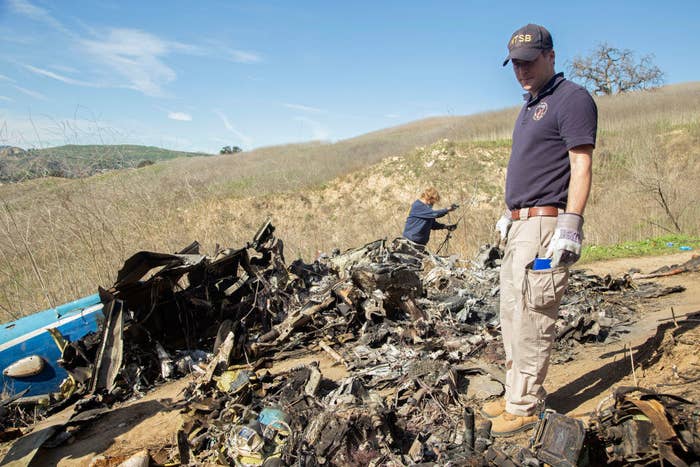
Federal officials announced Tuesday that the helicopter crash that killed Kobe Bryant and eight others last year occurred because the pilot likely got disoriented while flying into the clouds in violation of federal rules.
The pilot, Ara Zobayan, who also died in the Jan. 26, 2020, crash in Calabasas, California, was operating the Sikorsky S-76B helicopter under rules that prevented him from flying into clouds. However, he did not follow his training and continued into the clouds just before the aircraft crashed into a foggy hill, investigators said.
The crash also killed Bryant's 13-year-old daughter, Gianna, two other teenage girls with their family members, along with a basketball coach. The victims were on their way from Orange County to a girls basketball game at Bryant’s Mamba Sports Academy.
While encountering the foggy weather conditions, Zobayan notified air traffic controllers that he was climbing to 4,000 feet to get above the cloud layer, when in actuality, the helicopter was actually "descending rapidly," federal investigators said during a National Transportation Safety Board (NTSB) hearing on Tuesday.
The NTSB determined that Zobayan likely experienced "spatial disorientation," a misleading sensation that confuses pilots into not knowing "which way is up or down."
Investigators also said that given his "very close" friendship with Bryant over the years during which the NBA legend entrusted him to fly his children alone to basketball games, Zobayan may have experienced "self-induced pressure" to complete the flight so as to not disappoint Bryant.
While the NTSB said there was no evidence to suggest that the pilot's employer, Island Express, or Bryant himself, placed any pressure on Zobayan to accept the charter flight or to complete it, the "self-induced pressure can adversely affect pilot-decision making and judgment."
Investigators indicated that the pilot's self-induced pressure may have been a factor in "plan continuation bias," which means that the pilot continued the flight without engaging in an alternative course of action, like landing at a nearby airport, despite the deteriorating weather conditions.

NTSB officials said that the pilot was aware of the terrain before the flight and that the "weather did not sneak up" on him.
When encountering the difficult weather conditions during the flight, Zobayan could have chosen to land the helicopter at a nearby airport that was just a few minutes away, NTSB lead investigator Bill English said during the hearing.
While climbing into the clouds, Zobayan lost outside visual references that can lead to a "false sense of orientation" owing to inner ear "illusions," investigators said. This can trigger pilots' perception to believe they are flying straight and level when in reality they are in flying in a steady left turn — a phenomenon referred to as "the leans."
Once Zobayan flew into the clouds, he incorrectly perceived that he was climbing up, when in reality, "the helicopter was in a tightening left turn and descending rapidly," investigators said.
"This maneuver is consistent with the pilot experiencing spatial disorientation and limited visibility conditions," officials said.
During the descent, the pilot communicated with air traffic control on numerous occasions but did not declare an emergency, the NTSB said.
"The excessive speed entering the cloud, the rapid rate of decline, and the left turn were inconsistent with his training," the agency said.
Even while the helicopter was in a deep descent, the pilot either did not reference his instruments or had difficulty interpreting or believing them while being disoriented, and he subsequently lost control of the aircraft.
The NTSB said that from 2010 to 2019, there were 184 fatal aircraft accidents related to spatial disorientation, 20 of which were fatal helicopter accidents.
NTSB Chair Robert Sumwalt said that spatial disorientation did not mean the pilot was lost.
He said spatial disorientation means the pilot "may not know which way is up or down, whether he or she is leaning left or right."
"It's not like this crash happened because the pilot was flying along and did not know where the hills were and blundered into the side of a hill," Sumwalt said.
The crash is now at the center of several state and federal lawsuits, including a wrongful death lawsuit filed by Bryant's wife, Vanessa Bryant, who alleged negligence on the part of Zobayan and Island Express in causing the crash.
The complaint alleged that Zobayan "failed to properly monitor and assess the weather prior to takeoff," "failed to abort the flight when he knew of the cloudy conditions," and "improperly flew the helicopter into instrument flight rules conditions."
